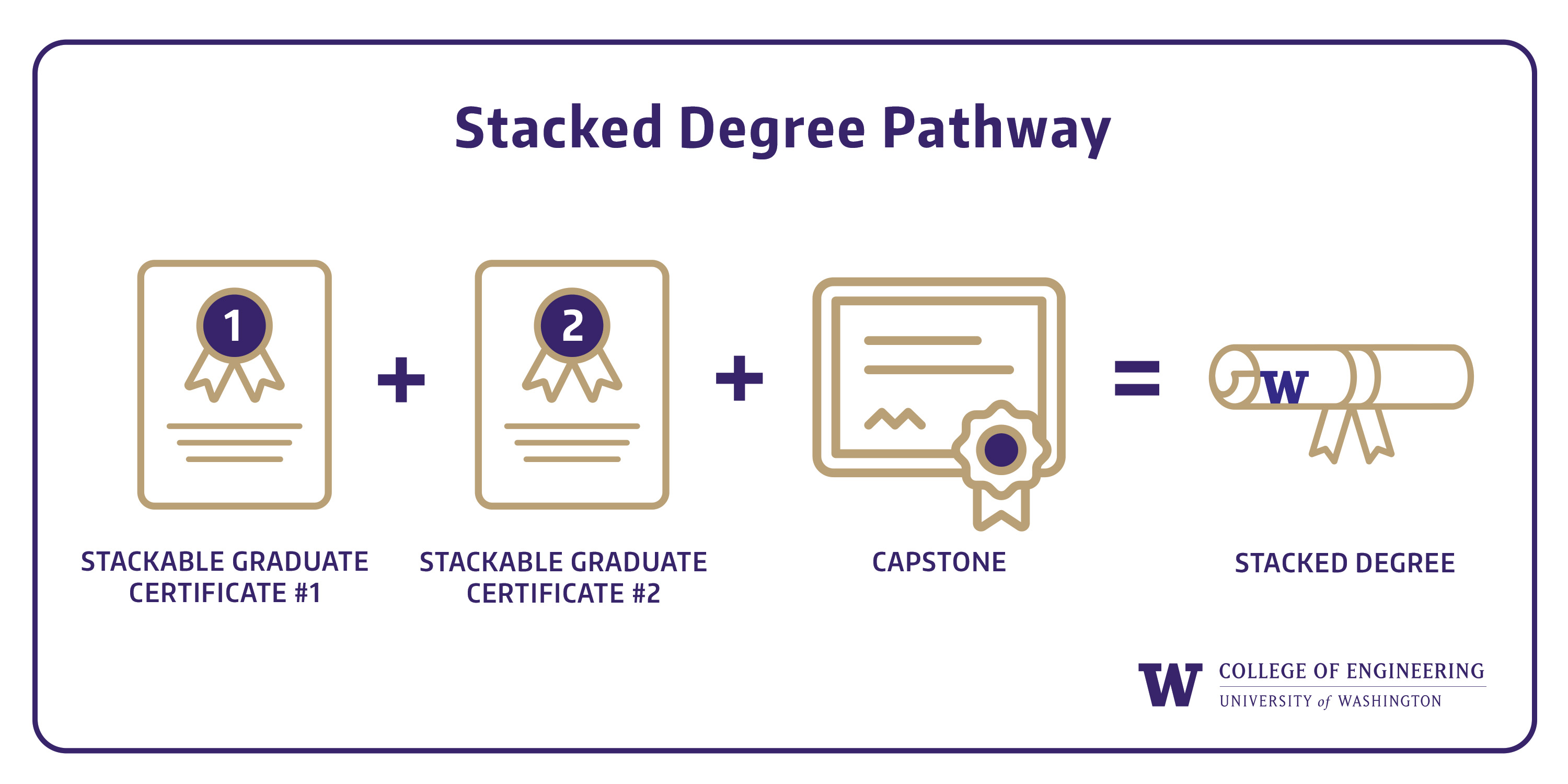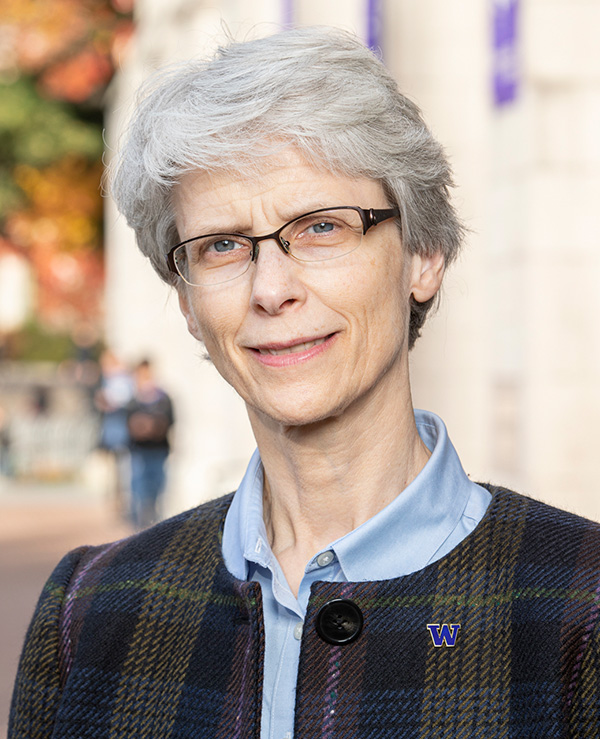By Ed Kromer
The College of Engineering’s innovative new graduate degree programs provide working engineers the customizable building blocks to grow and thrive as industries evolve.

The UW College of Engineering is renowned for innovation in many fields: artificial intelligence, robotics, biomedical devices, nanofabrication and clean energy, to name a few.
Now you can add graduate education to this list.
The College offers a new type of master’s degree that allows professional engineers to select from a menu of stackable certificate programs across a range of disciplines. Complete two certificates, plus an applied capstone project, to earn a “stacked” master’s degree.
It sounds simple. But a stacked master’s is a significant variation on the traditional degree. Both new stacked options — the Master of Science in Artificial Intelligence & Machine Learning (AI & ML) for Engineering and the Master of Engineering in Multidisciplinary Engineering — are the first such degrees at the UW and among the first anywhere.
“Stacked degrees, or ‘incremental credentials,’ are an innovative way forward in 21st century higher education that offers more flexible and modular education for professional learners,” says Kima Cargill, the associate dean for academic affairs at the UW Graduate School. “While many universities are exploring stacking credentials, few have launched a comprehensive portfolio of programs at the scale of the UW College of Engineering.”

Meeting market demand
Like any viable innovation, this one started with a need.
The College of Engineering has long met the demand for advanced learning with a wide array of traditional master’s degrees.
But industries are evolving at the blistering pace of technology. And, for some engineers, evolving with these industries requires more expansive and diverse sets of expertise. This insight, developed in close partnership with industry leaders and the College advisory board, seeded the stacked master’s programs.
“Industry is telling us that multidisciplinary engineering is the future and working professionals desire graduate education that can flexibly meet their unique career goals,” says Cassady Glass Hastings, the College’s director of new programs and innovation. “Stacked master’s degrees seemed like a great opportunity to be innovative while meeting industry demand and the curricular flexibility that working professionals want.”
Fast track
It can take many years to launch a new degree program in a large university — let alone new degree programs that cross disciplinary boundaries.
The stacked master’s degrees, however, coalesced in just two. Once the UW Graduate School changed university policy to allow stacked degrees, Glass Hastings quickly cultivated an “ecosystem of stackability,” ushering 18 new programs through the University’s rigorous, 11-step approval process.
She says this effort was guided by the College’s strategic commitment to innovate professional education and accelerated by departmental faculty and staff who quickly embraced the vision.
“We now have stackable certificate programs in seven of our academic units as well as new multi-department collaborations in fields that transcend disciplines, such as AI and battery engineering,” Glass Hastings says. “And robotics is coming soon.”

“The most exciting and pressing challenges in engineering today demand multidisciplinary solutions. By integrating expertise across disciplines, we are setting the trend for the future of engineering education and preparing graduates to lead innovation in an ever-evolving world.”
Flexibility is key
The essential component of both stacked master’s degree programs is flexibility. In several dimensions.
Certificate class schedules are part-time and designed to accommodate full-time work. Many are offered online. And pacing is personalized. Program architecture allows up to six years to complete two certificates and a capstone. Students can enroll continuously or stop and start as personal and professional demands permit, spreading out the commitment of time and money required to earn a graduate degree. “The beauty of stackable certificates is that they allow you to upskill over time, earning a series of valuable credentials from the UW — and all learning applies toward a master’s degree,” Glass Hastings says. “You can start with one certificate program and see where it takes you.”
The biggest source of flexibility, though, is the wide array of certificates to choose from.
The stacked master’s degree in AI & ML for Engineering pairs a foundational certificate with your choice of four discipline-specific, data-intensive certificates.
The master’s degree in Multidisciplinary Engineering offers even more flexibility to bundle any two of 15 stackable certificates across different disciplines — a set of building blocks that can be stacked in myriad combinations to meet career challenges and goals.
For instance, you might pair Aerospace Control Systems with AI & ML for Engineering. Or Modern AI Methods with User-Centered Design. Or Systems Engineering Leadership with Composite Materials and Manufacturing.
“You get to choose your own adventure,” Glass Hastings says.
An industry capstone completes both degrees. The AI & ML for Engineering capstone project is team oriented and data intensive, while the Multidisciplinary Engineering capstone is an independent project often related to the student’s organization or industry.
Expandable ecosystem
The ecosystem of building blocks that comprise the stacked master’s degrees is designed to grow.
In addition to the initial certificate offerings of the stacked master’s degree program, Glass Hastings is working to build out this interdisciplinary ecosystem across the College of Engineering and beyond. A stackable certificate/degree in robotics is in the works. And the College has been invited to extend stacked degrees across that UW, pairing engineering certificates with certificates offered by the Information School and the Foster School of Business.
“The most exciting and pressing challenges in engineering today demand multidisciplinary solutions, and our new stacked master’s degree program empowers students to tailor their education to tackle these complex problems head-on,” adds Nancy Allbritton, dean of the College of Engineering. “By integrating expertise across disciplines, we are setting the trend for the future of engineering education and preparing graduates to lead innovation in an ever-evolving world.”
The building blocks of modern engineering
The College of Engineering offers 15 graduate certificates that can be uniquely stacked to earn two different master’s degrees:
- Master of Science in Artificial Intelligence & Machine Learning for Engineering – a timely program that teaches professional engineers to leverage AI and machine learning tools to solve complex engineering challenges.
- Master of Engineering in Multidisciplinary Engineering – a one-of-a-kind degree that prepares engineers for a future where innovative solutions require the combination of skills in two or more disciplines.
The first step is enrolling in a certificate.
Originally published May 6, 2025